Sizzling Gambas, a cornerstone of modern Filipino cuisine, represents the perfect marriage of Spanish influence and Filipino culinary artistry. This iconic dish features succulent shrimp (hipon) bathed in a rich, spicy-garlic sauce, dramatically served on a sizzling hot plate that releases an irresistible aroma across the dining table.
Our version elevates the classic recipe with a perfect balance of fresh tomatoes, aromatic garlic, and carefully calibrated heat, creating a sauce that's both sophisticated and deeply satisfying. The signature sizzle not only adds theatrical flair but also continues to cook the sauce slightly, developing a caramelized depth that makes this dish absolutely unforgettable.
This recipe delivers the authentic taste of a beloved Filipino favorite that's captivated diners for generations.
Jump to:
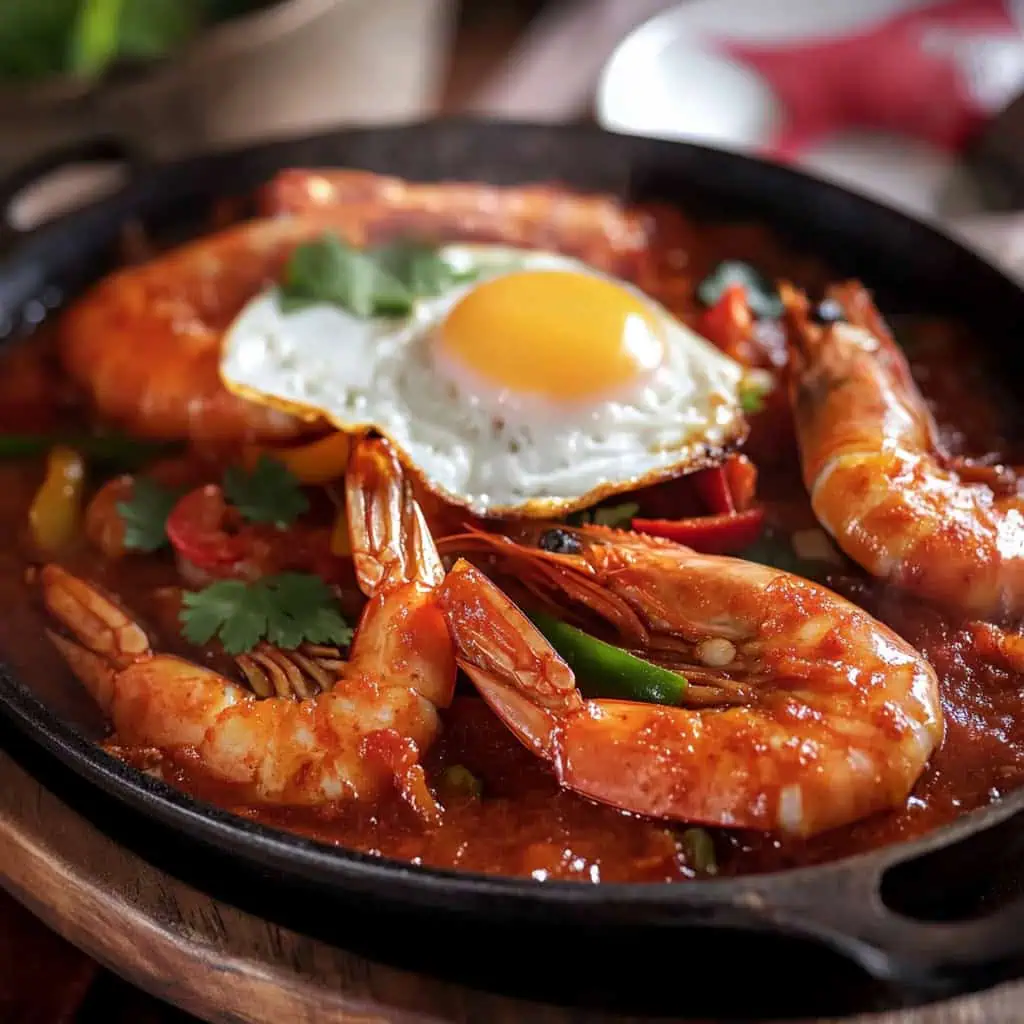
Why You'll Love This Recipe
- Restaurant-quality results in your own kitchen
- Perfectly balanced flavors: spicy, garlicky, and tangy
- Customizable heat level to suit your preference
- Ready in just 30 minutes (excluding marination time)
- Impressive presentation on a sizzling plate
- Budget-friendly alternative to restaurant dining
Ingredients
This sizzling gambas recipe uses carefully selected ingredients that work together to create the perfect balance of flavors. Fresh shrimp forms the heart of the dish, while calamansi adds brightness and helps tenderize the meat. The combination of butter and garlic creates a rich, aromatic base, while tomatoes and bell peppers provide sweetness and texture.
The spice blend — chili flakes, cayenne, and chili powder — delivers customizable heat, and Worcestershire sauce adds depth with its savory umami notes. Rice wine helps deglaze the pan and adds subtle complexity.
Together, these ingredients create a harmonious sauce that clings perfectly to the succulent shrimp, delivering that authentic restaurant-quality flavor in every bite.
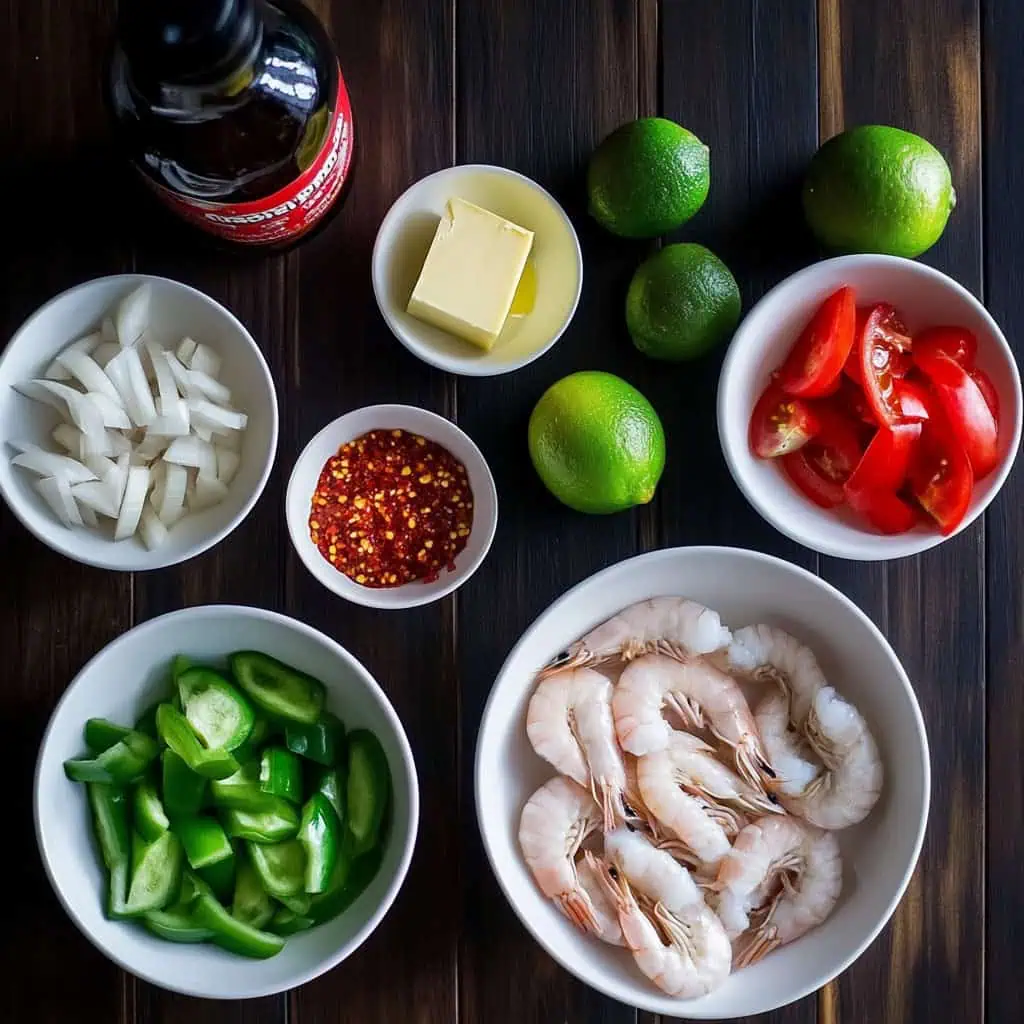
- 1 kilogram large shrimp, cleaned and deveined
- 3-4 pieces calamansi or 2 tablespoons calamansi juice
- 1 tablespoon salt
- 3 tablespoons cooking oil
- 1 stick (½ cup) butter
- 3 tablespoons minced garlic
- 1 white onion, sliced
- 4 medium red tomatoes, diced
- 1 cup green bell pepper, chopped
- 2 tablespoons cooking rice wine/Shaoxing wine (optional)
- ¼ cup hot sauce or 1 cup tomato sauce
- 1 tablespoon Worcestershire sauce
- 1 tablespoon chili flakes
- 1 teaspoon chili powder
- 1 teaspoon cayenne pepper powder
- Salt and pepper to taste
Optional Garnish:
- Fried egg
- Fresh cilantro
- Green onions
Equipment
- Sizzling plate: Essential for that iconic restaurant-style presentation and continuous cooking that develops flavor
- Large skillet or wok: Provides even heat distribution while cooking and enough space for ingredients
- Sharp knife: For precisely preparing vegetables and properly cleaning shrimp
- Cutting board: Sturdy surface for safe ingredient preparation
- Measuring spoons and cups: Ensures precise measurements for consistent results
- Tongs: Allows for gentle handling of shrimp while cooking to prevent tearing
- Small bowls: Helpful for ingredient organization and mise en place
- Wooden spoon: For gentle stirring that won't damage the delicate shrimp
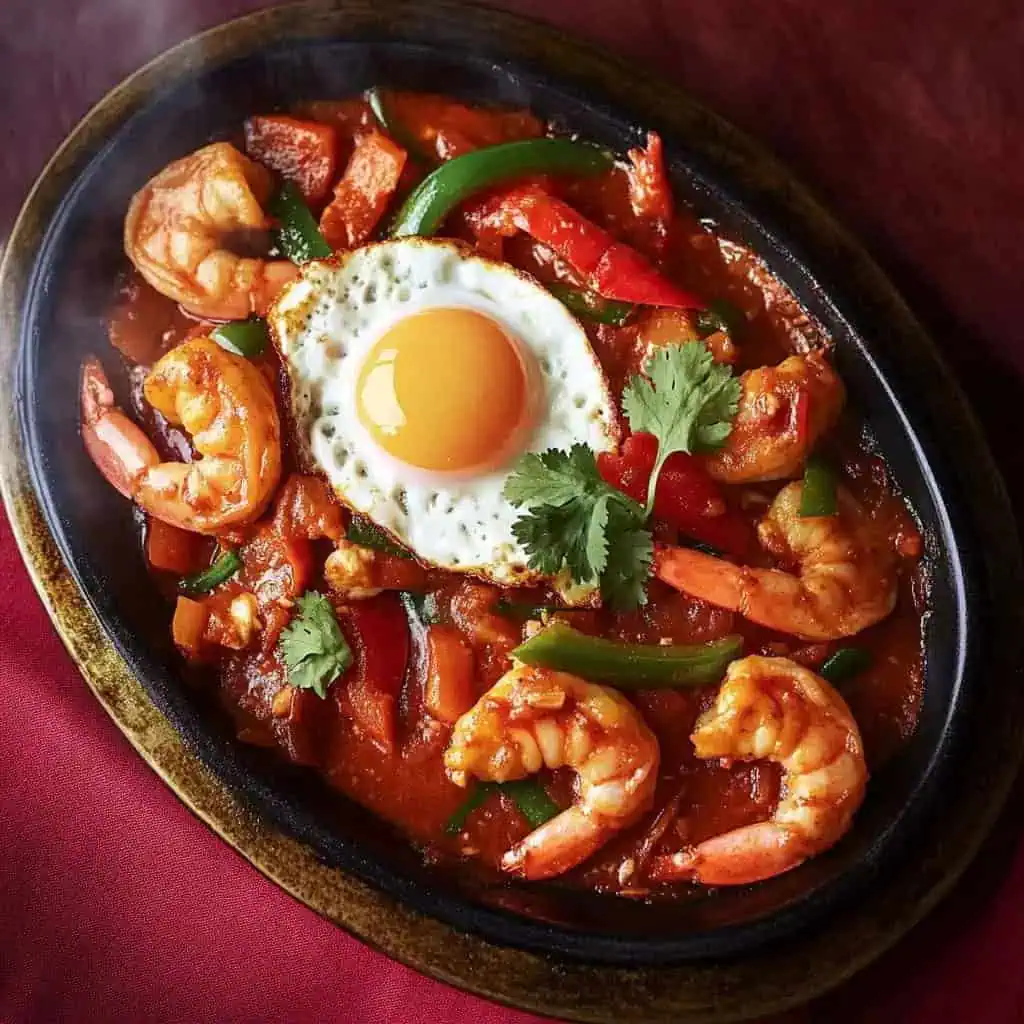
How To Make
- Start by marinating the shrimp. In a large bowl, mix the cleaned shrimp with calamansi juice and 1 tablespoon of salt. Let this sit for 30 minutes at room temperature.
- While waiting, prepare all your ingredients and have them ready beside your stove. This will make cooking smoother.
- Heat your pan over medium heat (180°C/350°F). Add the cooking oil and minced garlic. Cook the garlic until it turns light brown, about 1-2 minutes. Add the butter and let it melt completely.
- Add your sliced onions to the pan. Cook them until they become soft and clear, about 2-3 minutes. Now add the chopped tomatoes and cook for 5-7 minutes over medium heat (170°C/340°F). Gently press the tomatoes with your spoon while cooking to help them break down.
- Take your marinated shrimp out of the bowl and drain off the marinade. Add the shrimp to your pan and cook for just 2 minutes over medium-low heat (160°C/320°F). The shrimp should only turn pink – don't overcook them or they'll become tough.
- Add the rice wine to the pan and cook for one minute to let the alcohol cook off. Add your bell peppers, tomato sauce, and Worcestershire sauce. Season everything with chili flakes, cayenne pepper, chili powder, salt, and black pepper to taste. Cook over low heat (150°C/300°F) just until everything is hot and well combined.
- Get your sizzling plate very hot. Carefully transfer the gambas onto the hot plate. If you like, top it with a fried egg. Serve right away while the plate is still sizzling and the sauce is bubbling.
- Best enjoyed immediately with hot rice. Remember, the sizzling plate is extremely hot - warn your guests before serving.

Tips from Lola's Kitchen
- Use head-on shrimp for more intense flavor in the sauce
- Choose fresh, not frozen shrimp for best texture and taste
- Clean shrimp thoroughly but keep tails on for elegant presentation
- Don't overcrowd the pan to ensure proper cooking and browning
- Pat shrimp dry before cooking to achieve better searing and caramelization
- Heat the sizzling plate until smoking hot before adding the gambas for the perfect sizzle
- Prepare all ingredients before starting to cook for a smooth workflow
- Try butterfly-cutting larger shrimp for more even cooking and an impressive look
- Use butter-flavored oil for the sizzling plate to prevent burning
- Add a splash of lemon juice just before serving for brightness
Substitutions
- Calamansi → Lemon or lime juice: Use 1 tablespoon of either as a substitute
- Fresh tomatoes → Canned diced tomatoes: Drain excess liquid first
- Rice wine → White wine or chicken broth: Both provide depth without the alcohol
- Worcestershire sauce → Soy sauce + vinegar: Mix 2 teaspoons soy sauce with 1 teaspoon vinegar
- Green bell peppers → Mixed bell peppers or asparagus: For color variation and different flavor notes
- Hot sauce → Fresh chilies: Adjust quantity based on heat preference
- Butter → Olive oil: For a lighter version, though you'll miss some richness
- Large shrimp → Medium shrimp: Reduce cooking time by 30 seconds
- Cayenne → Paprika: For a milder, smokier flavor profile
Troubleshooting
- Rubbery Shrimp: You've overcooked them. Reduce cooking time; remove from heat as soon as shrimp turns pink. Remember that residual heat continues cooking them.
- Watery Sauce: Either cook tomatoes longer to reduce liquid or add 1 teaspoon cornstarch mixed with 1 tablespoon water to thicken.
- Not Spicy Enough: Add more chili flakes or fresh bird's eye chilies. You can also stir in a teaspoon of chili garlic paste.
- Too Spicy: Add more butter or tomato sauce to mellow the heat. A teaspoon of sugar can also balance excessive spiciness.
- Burnt Garlic: Start over with fresh garlic as burnt garlic creates bitter flavors. Keep heat at medium-low when cooking garlic.
- Sizzling Plate Not Hot Enough: Preheat longer next time. For now, quickly reheat it in the oven or over a high flame before transferring the gambas.
- Shrimp Sticks to Pan: Ensure pan is properly oiled before adding shrimp and don't move them until they naturally release.
Storage & Reheating
Refrigeration:
- Store in an airtight container for up to 2 days
- Keep sauce and shrimp separate if possible to prevent overcooking
Freezing:
- Not recommended as it significantly affects shrimp texture
- If necessary, freeze sauce only and cook fresh shrimp when serving
Reheating:
- Stovetop (Preferred): Heat sauce in pan until bubbling, then add refrigerated shrimp just until warmed through (1-2 minutes)
- Microwave: Use 30-second intervals with a splash of water and cover with a damp paper towel
- Always use medium heat to prevent overcooking the shrimp
- For best results, consider setting aside some uncooked shrimp and cooking them fresh when reheating the sauce
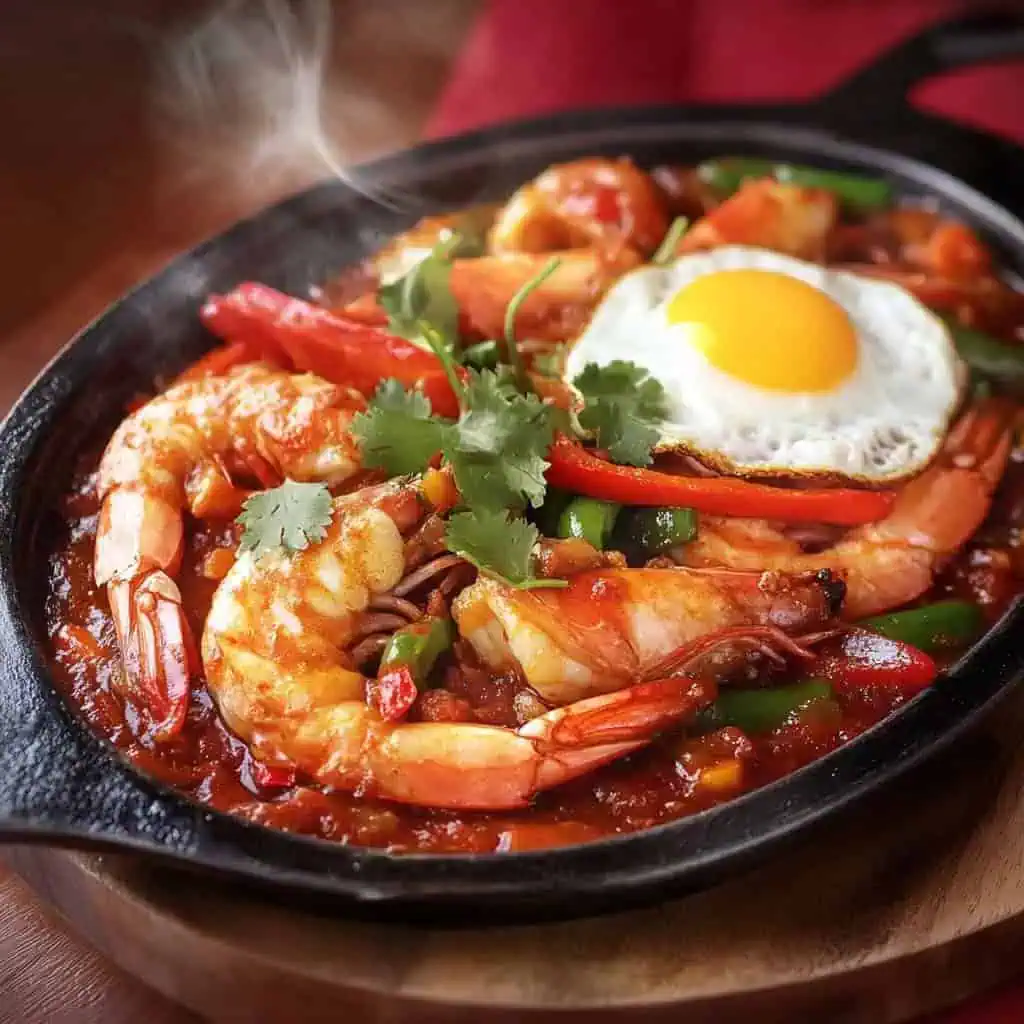
FAQ
Why did my shrimp turn tough?
Overcooked shrimp becomes tough. Cook just until pink (2-3 minutes) and remember that they continue cooking from residual heat. Remove them from heat at the first sign of pinkness for perfect texture.
Can I prepare this in advance for a party?
This dish is best served fresh. You can prep all ingredients ahead and even pre-cook the sauce base, but cook the shrimp just before serving. The sizzling presentation is part of the appeal and loses impact if prepared too far in advance.
Is this recipe very spicy?
The heat level is customizable. Start with half the spice amounts if you prefer milder food and adjust upward. You can always add more heat, but you can't remove it once added.
Can I use frozen shrimp?
Yes, but thaw completely and pat dry before cooking. Fresh shrimp provides better flavor and texture, but high-quality frozen shrimp can work well when properly thawed and dried.
How do I clean the shrimp properly?
Remove the head (optional, but keeps sauce cleaner), shell (leaving tail for presentation), and devein by making a shallow cut along the back and removing the dark intestinal tract. You can butterfly them by deepening this cut for faster cooking and elegant appearance.
What's the best sizzling plate to use?
Cast iron sizzling plates retain heat best. Ceramic plates with wooden bases are also good. Always preheat properly and handle with protective gloves to prevent burns.
Can I make this dish without a sizzling plate?
While the sizzle adds drama and continues cooking the sauce, you can serve directly from a hot skillet or transfer to a warm serving dish. The flavor will still be excellent, even without the sizzling effect.
How can I make this dish healthier?
Reduce butter by half and increase oil slightly, use more vegetables, and serve with brown rice or quinoa instead of white rice. You can also use less salt and rely more on herbs and citrus for flavor.
Related
Looking for other recipes like this? Try these:
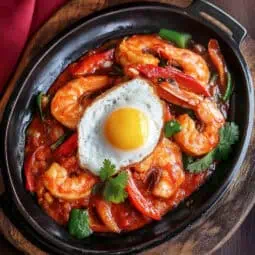
Sizzling Gambas Recipe (Restaurant-Style)
Equipment
- Sizzling plate For that iconic restaurant-style presentation
- Large skillet or wok (Kawali) For even heat distribution while cooking
- Sharp knife (kutsilyo) For preparing vegetables and cleaning shrimp
- Cutting board (Sangkalan) For ingredient preparation
- Measuring spoons and cups (panukat) For precise measurements
- Tongs [Sipit] For handling shrimp while cooking
- Small bowls For ingredient organization
- Wooden spoon (sandok na kahoy) For gentle stirring
Ingredients
For the Shrimp:
- 1 kilogram large shrimp Hipon, cleaned and deveined
- 3-4 pieces calamansi Philippine lime or 2 tablespoons calamansi juice
- 1 tablespoon salt Asin
For the Sauce:
- 3 tablespoons cooking oil
- 1 stick ½ cup butter
- 3 tablespoons minced garlic Bawang
- 1 white onion Sibuyas, sliced
- 4 medium red tomatoes Kamatis, diced
- 1 cup green bell pepper Berdeng siling pangsigang, chopped
- 2 tablespoons cooking rice wine Shaoxing wine (optional)
- ¼ cup hot sauce or 1 cup tomato sauce
- 1 tablespoon Worcestershire sauce
- 1 tablespoon chili flakes Paminta
- 1 teaspoon chili powder
- 1 teaspoon cayenne pepper powder
- Salt Asin and pepper (Paminta) to taste
Optional Garnish:
- Fried egg Pritong itlog
- Fresh cilantro Wansuy
- Green onions Dahon ng sibuyas
Instructions
- Start by marinating the shrimp. In a large bowl, mix the cleaned shrimp with calamansi juice and 1 tablespoon of salt. Let this sit for 30 minutes at room temperature.
- While waiting, prepare all your ingredients and have them ready beside your stove. This will make cooking smoother.
- Heat your pan over medium heat (180°C/350°F). Add the cooking oil and minced garlic. Cook the garlic until it turns light brown, about 1-2 minutes. Add the butter and let it melt completely.
- Add your sliced onions to the pan. Cook them until they become soft and clear, about 2-3 minutes. Now add the chopped tomatoes and cook for 5-7 minutes over medium heat (170°C/340°F). Gently press the tomatoes with your spoon while cooking to help them break down.
- Take your marinated shrimp out of the bowl and drain off the marinade. Add the shrimp to your pan and cook for just 2 minutes over medium-low heat (160°C/320°F). The shrimp should only turn pink – don't overcook them or they'll become tough.
- Add the rice wine to the pan and cook for one minute to let the alcohol cook off. Add your bell peppers, tomato sauce, and Worcestershire sauce. Season everything with chili flakes, cayenne pepper, chili powder, salt, and black pepper to taste. Cook over low heat (150°C/300°F) just until everything is hot and well combined.
- Get your sizzling plate very hot. Carefully transfer the gambas onto the hot plate. If you like, top it with a fried egg. Serve right away while the plate is still sizzling and the sauce is bubbling.
- Best enjoyed immediately with hot rice. Remember, the sizzling plate is extremely hot - warn your guests before serving.
Tips from Lola's Kitchen
- Choose fresh, not frozen shrimp for best results
- Clean shrimp thoroughly but keep tails on for presentation
- Don't overcrowd the pan to ensure proper cooking
- Pat shrimp dry before cooking to achieve better searing
- Use butter-flavored oil for the sizzling plate to prevent burning
Nutrition
The Story Behind Sizzling Gambas
The journey of sizzling gambas from Spanish tapas bars to Filipino restaurant tables is a testament to the Philippines' rich culinary heritage of adapting and elevating global flavors. Originally inspired by the Spanish dish "gambas al ajillo" (garlic shrimp), Filipino chefs transformed this simple appetizer into a theatrical main course that has become a staple in restaurants across the archipelago.
In the 1980s, as sizzling plate dishes gained popularity in the Philippines, innovative local chefs began experimenting with the traditional Spanish gambas recipe. They added distinctly Filipino elements like calamansi, created a richer sauce with fresh tomatoes, and most importantly, served it on the now-iconic sizzling plate that's become synonymous with special occasion dining in Filipino restaurants.
The addition of the sizzling plate wasn't just for dramatic effect – though the sight and sound of a smoking hot plate arriving at the table certainly adds to the experience. The extreme heat continues to caramelize the sauce as it's served, creating those coveted charred bits around the edges that Filipino food lovers eagerly scrape onto their rice. This cooking technique, known locally as "sizzling style" or "sa mainit na plato," has become so popular that it's now used for numerous Filipino dishes.
What sets Filipino-style gambas apart from its Spanish ancestor is the complex layering of flavors. While Spanish gambas al ajillo focuses primarily on garlic and olive oil, the Filipino version builds a more elaborate flavor profile. The sauce, with its perfect balance of garlic, tomatoes, and spice, creates what many consider the ideal sawsawan (sauce) for rice – a crucial element in Filipino cuisine where rice is an essential part of every meal.
Today, sizzling gambas holds a special place in Filipino restaurant culture. From humble carinderias to upscale restaurants like Gerry's Grill (which helped popularize the dish nationwide), each establishment puts its own spin on this beloved seafood dish. Some versions lean into the heat with additional chilies, while others focus on the garlic-butter harmony that makes the sauce so irresistible. This recipe captures the best of both worlds – authentic enough to remind you of your favorite restaurant's version, yet adaptable enough to make it your own.
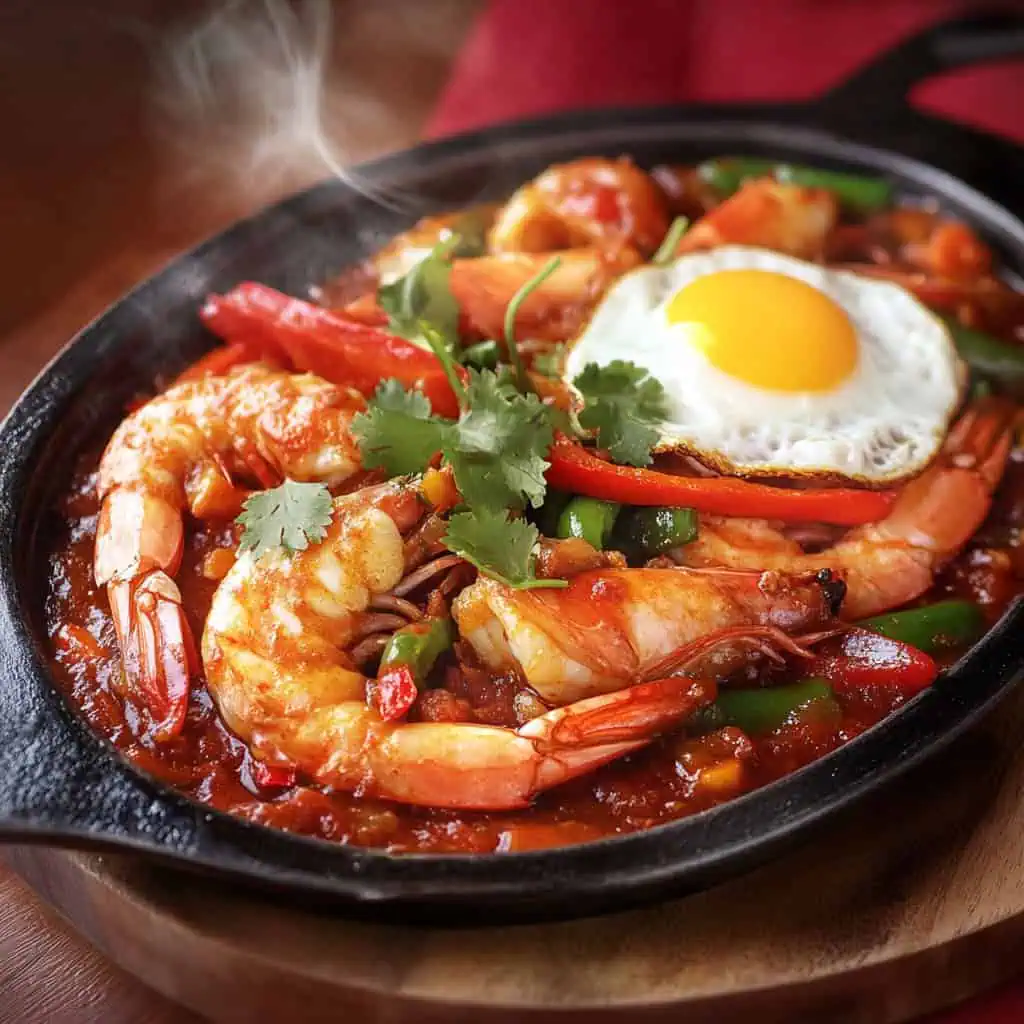









Comments
No Comments